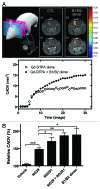Dual kinin B1 and B2 receptor activation provides enhanced blood-brain barrier permeability and anticancer drug delivery into brain tumors
- PMID: 23792591
- PMCID: PMC3909549
- DOI: 10.4161/cbt.25327
Dual kinin B1 and B2 receptor activation provides enhanced blood-brain barrier permeability and anticancer drug delivery into brain tumors
Abstract
The low permeability of the BBB is largely responsible for the lack of effective systemic chemotherapy against primary and metastatic brain tumors. Kinin B1R and B2R have been shown to mediate reversible tumor-selective BBB disruption in preclinical animal models. We investigated whether co-administration of two novel potent kinin B1R and B2R agonists offers an advantage over administering each agonist alone for enhancing BBB permeability and tumor targeting of drugs in the malignant F98 glioma rat model. A new covalent kinin heterodimer that equally stimulates B1R and B2R was also constructed for the purpose of our study. We found that co-administration of B1R and B2R agonists, or alternatively administration of the kinin heterodimer more effectively delivered the MRI contrast agent Gd-DTPA and the anticancer drug carboplatin to brain tumors and surrounding tissues than the agonists alone (determined by MRI and ICP-MS methods). Importantly, the efficient delivery of carboplatin by the dual kinin receptor targeting on the BBB translated into increased survival of glioma-bearing rats. Thus, this report describes a potential strategy for maximizing the brain bioavailability and therapeutic efficacy of chemotherapeutic drugs.
Keywords: G protein-coupled receptors; MRI; blood–brain barrier; glioma; kinins; rat; synthetic agonists.
Figures





References
Publication types
MeSH terms
Substances
LinkOut - more resources
Full Text Sources
Other Literature Sources
Medical
